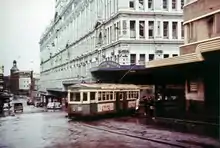.jpg.webp)
Brickfield Hill is a City of Sydney locality in inner city Sydney, Australia. The name was used for the surrounding settlement serving the colony's growing need for bricks, and today is part of the suburb of Surry Hills.[1]
History

Brickfield Hill was a Sydney postal address until postcodes were introduced in 1967, and roughly covered the area between Sydney Town Hall and Central Station. The area was used for brick-making, hence the term, up until the 1840s when land values rose and merchant stores, warehouses, and housing became more prominent, although the area remained a relatively poor 'slum' area of the city.[2][3] In 1905, following the destruction of their Haymarket store by fire in 1901, Anthony Hordern & Sons opened their new "Palace Emporium" on Brickfield Hill, the construction of which involved the demolition of several houses including Samuel Hordern's birthplace.[4][5][6][7] Following the demise of the Hordern retailing empire, the building was used by the New South Wales Institute of Technology Faculty of Business and later also Faculty of Law, from 1967 to 1984.[8] The building was controversially demolished in 1985–1986 and was eventually replaced by the World Square development.[9]
See also
- Jack Lang, 23rd Premier of New South Wales, was born in Brickfield Hill in 1876.
- Brickfielder, the hot wind, takes its name from Brickfield Hill[10]
- Devonshire Street Cemetery, incorrectly known as Brickfield Hill Cemetery as it was located in this area.
- Athenaeum Theatre, Sydney, short-lived entertainment venue at 610 George Street
References
- ↑ "Brickfield Hill". the Dictionary of Sydney. Retrieved 16 April 2018.
- ↑ Huxley, John (26 September 2008). "Brickaholic's tale goes behind the history of Sydney's 'golden mile'". The Sydney Morning Herald. Retrieved 16 April 2018.
- ↑ "Brickfield Hill". Evening News. No. 11, 376. New South Wales, Australia. 26 November 1903. p. 3. Retrieved 16 April 2018 – via National Library of Australia.
- ↑ "A Big Enterprise on Brickfield Hill". Australian Town and Country Journal. Vol. LXVIII, no. 1771. New South Wales, Australia. 13 January 1904. p. 52. Retrieved 16 April 2018 – via National Library of Australia.
- ↑ "Old Sydney". Truth. No. 1910. New South Wales, Australia. 15 August 1926. p. 17. Retrieved 16 April 2018 – via National Library of Australia.
- ↑ "Old Sydney". Truth. No. 1911. New South Wales, Australia. 22 August 1926. p. 24. Retrieved 16 April 2018 – via National Library of Australia.
- ↑ "Old Sydney". Truth. No. 1913. New South Wales, Australia. 5 September 1926. p. 24. Retrieved 16 April 2018 – via National Library of Australia.
- ↑ "UTS Timeline". University of Technology, Sydney. Retrieved 27 May 2022.
- ↑ "The End of the Hordern Building". The Canberra Times. Vol. 59, no. 18, 122. Australian Capital Territory, Australia. 12 May 1985. p. 57. Retrieved 16 April 2018 – via National Library of Australia.
- ↑ Wilkes, G.A. 1978. A Dictionary of Australian Colloquialisms Fontana. ISBN 0-00-635719-9
External links